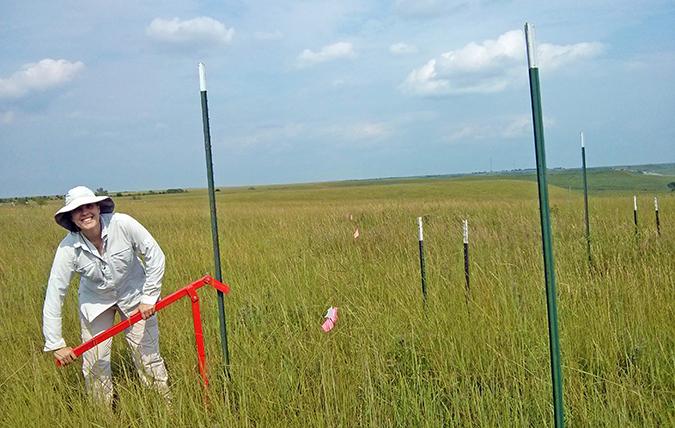
The National Socio-Environmental Synthesis Center (SESYNC) and the Long Term Ecological Research Network (LTER) are pleased to welcome Dr. Meghan Avolio, a SESYNC–LTER Postdoctoral Synthesis Fellow. Get to know our newest researcher:
Name: Meghan Avolio
PhD: Ecology and Evolutionary Biology, Yale University
Hometown: Croton-on-Hudson, NY
SESYNC Project: Developing new metrics for studying holistic community changes: A necessary new frontier in the Anthropocene
Mentors/Collaborators: Dr. Scott Collins, University of New Mexico, and Dr. Greg Houseman, Wichita State University
How would you describe your primary field of study?
Plant ecology.
What does that mean in terms of the broad questions you’re interested in studying?
I’m really interested in how humans impact plants—both indirectly through climate change and global change and directly through, for example, what we choose to plant in our yards. And I’m interested in these impacts across various scales: from changes in gene expression within individuals to changes in what scientists call ecosystem function. This could include how much carbon plants are sucking out of the atmosphere and how much nitrogen they’re helping cycle through the landscape.
Can you briefly describe your proposed SESYNC postdoctoral project?
One of the many hats I wear is that of community ecologist. And communities are messy: they contain many different species that are doing many different things and interacting in many different ways. That makes communities very difficult to study, so ecologists condense information about them down to single numbers that represent, for example, how many plant species exist in a given area. We call that ‘richness’. But these numbers don’t end up telling us very much: they don’t tell us whether those species have different abundances or whether one species is dominant (and if so, which one). All that information is lost.
At SESYNC, I will develop new methods for using rank abundance curves (RACs) to understand complex community changes in a generalizable way. RACs are useful as visualization tools to understand how communities are structured by capturing information on how common or rare a species is relative to other species in a defined location or community. My goal is to ultimately produce an R package to enable ecologists to rigorously test changes in RACs and detect changes in entire plant communities.
What value does the LTER data you’ll be using bring to your project?
I’m interested in how plant communities change. Because communities change slowly over time, I need long-term data to answer the questions my research asks. I can’t do it without LTERs.
And in fact, I’ve had the great pleasure of doing work at the Konza Prairie LTER for the past nine years. Next year will be my 10-year anniversary. We are going to make t-shirts; I’m very excited!
Why are you making the move from outdoor field research to “indoor” synthesis research?
Well, I don’t think the two are mutually exclusive. During my SESYNC postdoc I’ll still be going to Konza for three weeks each year, as I’m still involved in several other projects from which I’m continually accumulating new data.
But field work is time-intensive—you spend a lot of time collecting data but don’t necessarily have a lot of time to analyze it. As a synthesis postdoc, I’ll get to analyze data for two years straight. To me, data analysis is a creative and interactive process, and thrilling in its own way.
What’s the best professional advice you’ve ever received?
Love what you do—and when you stop loving it, stop doing it.
Could you describe a time when the element of ‘surprise’ played a role in your research?
I think I’m surprised by my research every day. As a community ecologist I get to be both naturalist and scientist, and it’s a nice way to experience working in the field. For example, I’ve been going to the Konza LTER every year for nine years. But on my most recent trip in August, the prairie was unrecognizable. It was a high precipitation year, and the grasses had grown so much they were over my head. I couldn’t see five feet in front of me. I was literally swimming in grasses. Maybe that’s less surprising and more just really cool, but then I’m a plant nerd.
What are you reading right now?
I’m re-reading Pride and Prejudice. Did you want something science-y? Even postdocs need a break!
The National Socio-Environmental Synthesis Center, funded through an award to the University of Maryland from the National Science Foundation, is a research center dedicated to accelerating scientific discovery at the interface of human and ecological systems. Visit us online at www.sesync.org and follow us on Twitter @SESYNC.